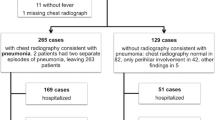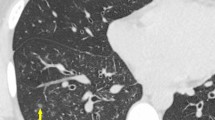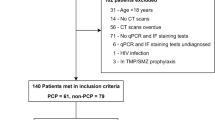Abstract
The purpose of the present study was to evaluate the accuracy and usefulness of three rapid diagnostic methods, ImmunoCard Mycoplasma kit, chest high-resolution computed tomography (HRCT) findings, and the Japanese Respiratory Society (JRS) scoring system (including six parameters), for the early presumptive diagnosis of Mycoplasma pneumoniae pneumonia in adults. We performed three rapid diagnostic methods at the same time in four pneumonia groups: 68 cases with M. pneumoniae pneumonia, 133 cases with Streptococcus pneumoniae pneumonia, 30 cases with Haemophilus influenzae pneumonia, and 20 cases with Legionella pneumonia. The sensitivity and specificity were 35% and 68% for ImmunoCard, 73% and 85% with HRCT, and 83% and 90% with the JRS scoring system, respectively. Among the three rapid diagnostic methods, the JRS scoring system was the most useful tool for initiating the administration of adequate antibiotic therapy for probable M. pneumoniae pneumonia. We suggest that M. pneumoniae pneumonia should be suspected when there is a correlation of more than five parameters in the JRS scoring system (99% specificity). If there is a correlation of three or four parameters in the JRS scoring system, chest computed tomography (CT) findings are helpful for the presumptive diagnosis of M. pneumoniae pneumonia.



Similar content being viewed by others
References
Atkinson TP, Balish MF, Waites KB (2008) Epidemiology, clinical manifestations, pathogenesis and laboratory detection of Mycoplasma pneumoniae infections. FEMS Microbiol Rev 32:956–973
Miyashita N, Fukano H, Mouri K, Fukuda M, Yoshida K, Kobashi Y, Niki Y, Oka M (2005) Community-acquired pneumonia in Japan: a prospective ambulatory and hospitalized patient study. J Med Microbiol 54:395–400
Matsushima T, Kohno S, Saito A et al (eds) (2005) The JRS guidelines for the management of community-acquired pneumonia in adults (in Japanese). The committee for the JRS guidelines in management of respiratory infections, the Japanese Respiratory Society, Tokyo, Japan
Miyashita N, Ouchi K, Kawasaki K, Oda K, Kawai Y, Shimizu H, Kobashi Y, Oka M (2008) Mycoplasma pneumoniae pneumonia in the elderly. Med Sci Monit 14:CR387–CR391
Marston BJ, Plouffe JF, File TM Jr, Hackman BA, Salstrom S-J, Lipman HB, Kolczak MS, Breiman RF; The Community-Based Pneumonia Incidence Study Group (1997) Incidence of community-acquired pneumonia requiring hospitalization. Results of a population-based active surveillance study in Ohio. Arch Intern Med 157:1709–1718
Miyashita N, Fukano H, Okimoto N, Hara H, Yoshida K, Niki Y, Matsushima T (2002) Clinical presentation of community-acquired Chlamydia pneumoniae pneumonia in adults. Chest 121:1776–1781
Miyashita N, Obase Y, Ouchi K, Kawasaki K, Kawai Y, Kobashi Y, Oka M (2007) Clinical features of severe Mycoplasma pneumoniae pneumonia in adults admitted to an intensive care unit. J Med Microbiol 56:1625–1629
Morozumi M, Takahashi T, Ubukata K (2010) Macrolide-resistant Mycoplasma pneumoniae: characteristics of isolates and clinical aspects of community-acquired pneumonia. J Infect Chemother 16:78–86
Miyashita N, Kawai Y, Yamaguchi T, Ouchi K, Oka M; Atypical Pathogen Study Group (2010) Macrolide-resistant Mycoplasma pneumoniae in adults with community-acquired pneumonia. Int J Antimicrob Agents 36:384–385
Miyashita N, Fukano H, Yoshida K, Niki Y, Matsushima T (2004) Is it possible to distinguish between atypical pneumonia and bacterial pneumonia?: evaluation of the guidelines for community-acquired pneumonia in Japan. Respir Med 98:952–960
Ishida T, Miyashita N, Nakahama C (2007) Clinical differentiation of atypical pneumonia using Japanese guidelines. Respirology 12:104–110
Alexander TS, Gray LD, Kraft JA, Leland DS, Nikaido MT, Willis DH (1996) Performance of Meridian ImmunoCard Mycoplasma test in a multicenter clinical trial. J Clin Microbiol 34:1180–1183
Matas L, Domínguez J, De Ory F, García N, Galí N, Cardona PJ, Hernández A, Rodrigo C, Ausina V (1998) Evaluation of Meridian ImmunoCard Mycoplasma test for the detection of Mycoplasma pneumoniae-specific IgM in paediatric patients. Scand J Infect Dis 30:289–293
Dunn JJ, Malan AK, Evans J, Litwin CM (2004) Rapid detection of Mycoplasma pneumoniae IgM antibodies in pediatric patients using ImmunoCard Mycoplasma compared to conventional enzyme immunoassays. Eur J Clin Microbiol Infect Dis 23:412–414
Miyashita N, Sugiu T, Kawai Y, Oda K, Yamaguchi T, Ouchi K, Kobashi Y, Oka M (2009) Radiographic features of Mycoplasma pneumoniae pneumonia: differential diagnosis and performance timing. BMC Med Imaging 9:7
Ito I, Ishida T, Togashi K, Niimi A, Koyama H, Ishimori T, Kobayashi H, Mishima M (2009) Differentiation of bacterial and non-bacterial community-acquired pneumonia by thin-section computed tomography. Eur J Radiol 72:388–395
Miyashita N, Obase Y, Fukuda M, Shouji H, Yoshida K, Ouchi K, Oka M (2007) Evaluation of the diagnostic usefulness of real-time PCR for detection of Chlamydophila pneumoniae in acute respiratory infections. J Infect Chemother 13:183–187
Ramirez JA, Ahkee S, Tolentino A, Miller RD, Summersgill JT (1996) Diagnosis of Legionella pneumophila, Mycoplasma pneumoniae, or Chlamydia pneumoniae lower respiratory infection using the polymerase chain reaction on a single throat swab specimen. Diagn Microbiol Infect Dis 24:7–14
Koide M, Higa F, Tateyama M, Sakugawa H, Saito A (2004) Comparison of polymerase chain reaction and two urinary antigen detection kits for detecting Legionella in clinical samples. Eur J Clin Microbiol Infect Dis 23:221–223
Hanley JA, McNeil BJ (1982) The meaning and use of the area under a receiver operating characteristic (ROC) curve. Radiology 143:29–36
Ozaki T, Nishimura N, Ahn J, Watanabe N, Muto T, Saito A, Koyama N, Nakane K, Funahashi K (2007) Utility of a rapid diagnosis kit for Mycoplasma pneumoniae pneumonia in children, and the antimicrobial susceptibility of the isolates. J Infect Chemother 13:204–207
Niki Y, Hanaki H, Matsumoto T, Yagisawa M, Kohno S, Aoki N et al (2009) Nationwide surveillance of bacterial respiratory pathogens conducted by the Japanese Society of Chemotherapy in 2007: general view of the pathogens’ antibacterial susceptibility. J Infect Chemother 15:156–167
Song JH, Jung SI, Ko KS, Kim NY, Son JS, Chang HH et al (2004) High prevalence of antimicrobial resistance among clinical Streptococcus pneumoniae isolates in Asia (an ANSORP study). Antimicrob Agents Chemother 48:2101–2107
Inoue M, Lee NY, Hong SW, Lee K, Felmingham D (2004) PROTEKT 1999–2000: a multicentre study of the antibiotic susceptibility of respiratory tract pathogens in Hong Kong, Japan and South Korea. Int J Antimicrob Agents 23:44–51
Yokota S, Sato K, Yoshida S, Fujii N (2004) Molecular epidemiology of fluoroquinolone-resistant Streptococcus pneumoniae in Japan. Kansenshogaku Zasshi 78:428–434 (in Japanese)
Yokota S, Ohkoshi Y, Sato K, Fujii N (2008) Emergence of fluoroquinolone-resistant Haemophilus influenzae strains among elderly patients but not among children. J Clin Microbiol 46:361–365
Acknowledgments
This study was supported in part by MEXT KAKENHI (grant nos. 19591190 and 21591304) and Project Research Grants from the Kawasaki Medical School (grant nos. 13-401, 14-402, 15-405A, 16-405 M, 17-402 M, 18-401, 19-402 M, and 20-4030).
Author information
Authors and Affiliations
Consortia
Corresponding author
Additional information
A complete list of participants of the Atypical Pathogen Study Group is located in the appendix.
Appendix
Appendix
The Atypical Pathogen Study Group is formed by: Takaya Maruyama and Osamu Taguchi (Mie University Graduate School of Medicine); Chikara Nakahama (Nakahama Clinic); Hirohide Yoneyama and Junichi Nakamura (Kasaoka Daiichi Hospital); Niro Okimoto (Kawasaki Hospital); Masayasu Kawanishi (Kaneda Hospital); Makoto Kimura (Kimura Clinic); Hiroki Hara and Toshiharu Matsushima (Kurashiki Daiichi Hospital); Masao Doi and Masao Kuwabara (Kenritsu Hiroshima Hospital); Kouji Hashiguchi (Nagasaki Genbaku Hospital); and Yasuhiro Nagatomo and Akihiko Okayama (University of Miyazaki).
Rights and permissions
About this article
Cite this article
Miyashita, N., Kawai, Y., Yamaguchi, T. et al. Clinical potential of diagnostic methods for the rapid diagnosis of Mycoplasma pneumoniae pneumonia in adults. Eur J Clin Microbiol Infect Dis 30, 439–446 (2011). https://doi.org/10.1007/s10096-010-1107-8
Received:
Accepted:
Published:
Issue Date:
DOI: https://doi.org/10.1007/s10096-010-1107-8




